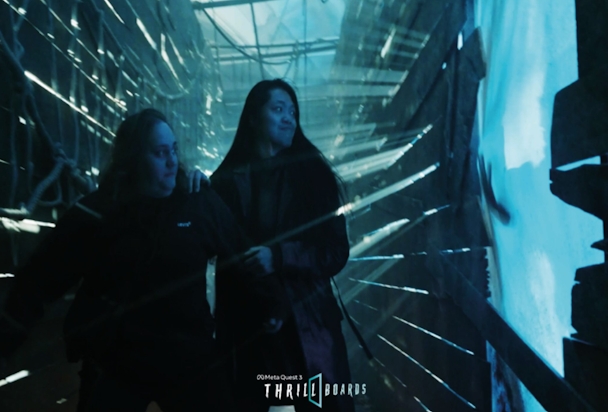Old dog, new tricks: how good old fashioned billboards changed the VR game for Meta Quest
Winning at The Drum Awards for Advertising in the Immersive Experience category was Meta Quest for a campaign that used billboards to bring VR to life. Here is the award-winning case study.

Award winning work
While Meta Quest is the category leader, the virtual reality (VR) headset category itself isn’t big. With the launch of Meta Quest 3 (MQ3) in the UK, Meta hoped to grow the category and with it their category share, using the new headset’s relatively accessible price point, vast library of content titles and its ace in the hole, the introduction of mixed reality (MR) functionality in the world's first mass-market headset.
For the UK’s tech heads, upgraders, and avid gamers who live and breathe these features, an emotionally compelling but ultimately product-driven campaign would be more than enough to get them to buy one.
But for the uninitiated, and more specifically for our target audience of culture drivers and trendsetters Gen Z, who’s uptake would normalize wider adoption of headsets, we had a bigger job to convince them that the price tag of £479.99 was worth it, for MR technology they knew nothing about.
On top of this, we were fighting a raft of existing perceptions. While it still sounds futuristic, VR technology and VR headsets aren’t new - nearly 90% of people can give you a good idea of what it is. But only 35% of 16-34-year-olds have actually tried it. As a result, people make assumptions, usually based on the typical image of someone cut off from reality and their environment.
Want to go deeper? Ask The Drum
The introduction of MR on Meta Quest 3 was Meta’s answer to making VR more interactive, more shareable, and less binary. Users would be able to supercharge their own surroundings and interact with virtual elements in the physical world to unlock entirely new experiences. But how could we explain this to people who had already made up their minds about VR headsets and dismissed them as an isolating, escapist, complex, and expensive piece of tech?
We had another problem. When people actually tried VR for themselves they were four times more likely to buy, but putting headsets on heads was impossible to do at scale. Meanwhile, traditional media was letting us down, with 2D formats unable to truly convey the incredibly immersive and interactive experience.
With mass trial unrealistic, somehow, and with the traditional channels available to us, we needed to reeducate a generation on the headset’s true potential, realised through MR.
On paper, MR, a tool that literally enhances the real world with digital elements, is perfect for Gen Z. Disproportionately restricted, they’re a generation striving to take back control of their world experience, to try, see, and do as much as they can. They invented the term ‘Main Character Energy’. They don’t want to cut themselves off from reality, they want to experience it all and at full throttle.
We saw this attitude reflected in their approach to Halloween - see the recent rise of walk-through horror houses, cosplay and interactive theatre. What better holiday than one dedicated to completely embracing, inhabiting and feeling every moment.
But ironically, the reality of most peoples' Halloween is a lot less thrilling than the content they consume, often limited to the confines of film screens or half hearted parties. But they didn’t have to be with the MQ3.
There would never be a more relevant or more receptive occasion to show off the new headset. But we still had the problem of explaining this new cutting-edge MR with just traditional channels.
Advertisement
Execution
We took inspiration from one of the oldest but soundest lessons in advertising - show don’t tell. Previous Quest campaigns had taught us exposition wasn’t enough. If the headset could blend the real and digital worlds and make the impossible possible, our creative idea needed to prove it - for real.
We deliberately decided to exploit people's expectations of one the most well known but least interactive media placements of all; OOH. At a time when every other billboard in the country would be plastered with 2D images of Halloween heroes and villains, we created unique 4D billboard experiences that would physically invite Gen Z to step beyond the surface and become one themselves.
We opened our 2 IP inspired walk-in billboards (one for Ghostbusters: Rise of the Ghost Lord and one for the Walking Dead: Saints & Sinners) to influencers, the press and the public over the Halloween weekend.
Stepping into our billboards our attendees would have to survive a pack of zombies on their way to a safe house, or battle a horde of mini StayPufts to get to the Ghostbusters HQ, recreating the in-game experiences in real life.
After experiencing the immersiveness of mixed reality in reality, they were then taken to try the headset version with a demo of the Meta Quest 3.
To match our billboards, we created a suite of assets that also physically demonstrated the real-world blending with the virtual.
Hyperrealistic CGI social posts teased the headset’s ability to make the impossible possible, showing oozing Stay Puft marshmallows pouring from the venue windows.
Advertisement
We encouraged excited attendees to share their own journeys as they stepped through the billboards themselves and transformed their real worlds into digitally enhanced ones, creating a raft of engaging and thumb-stopping organic content.
And to top it off, we amplified our campaign across influencer channels, Meta’s owned platforms and with earned headlines, using their unparalleled reach and engaged fan bases to drive intrigue and excitement for our new reality-defying experience and headset.
Like the transformation of VR to MR, across every media channel we took something singular in dimension and nonexploratory and turned it into something that blurred the lines between the physical world and imagination.
By drawing this parallel, our campaign didn’t just tell people about the MR feature, it showed it, to both attendees and nonattendees alike - a simple visual metaphor that translated across every medium, channel and format.
Suggested newsletters for you
Results
Gen Z couldn’t wait to step beyond the surface, with all slots for our reality bending experience being immediately booked out, generating a 1.4k waiting list that had to be closed within days.
Those that were lucky enough to attend the experience left with a totally new understanding and interest in the VR/MR category. Amongst Gen Z target attendees we saw huge spikes in Meta Quest content relevance (+33pts) and net promoter score (+67pts).
But most importantly, even those that weren’t able to experience it for real were reached and educated on the headset’s potential. From passers-by watching, to those scrolling Instagram, TikTok or the latest headlines, the easy ‘visual language’ of the walk in billboard told Meta Quest 3’s story in an instant. In just over 2 weeks we generated 29.1m impressions.
The naturally shareable ‘step in’ moment, the terrifying walk through tunnels and headset gameplay were all captured and shared across paid, earned and organic social channels, generating 24 press articles, benchmark breaking influencer content and some of LadBible and Meta’s ‘most engaged with’ and most positively received posts of the year.
And despite not being able to physically try it on, Gen Z non attendees who saw the experience across influencer content were more likely to believe that Quest content was relevant to them (+5pts lift) and more likely to recommend the headset (+9pts lift).
Finally, without trial, and by using one of the most traditional formats around, we had managed to not only explain what the headset could do, but got people genuinely excited about it.
